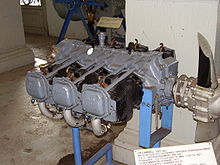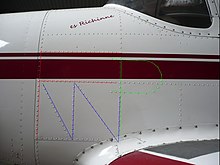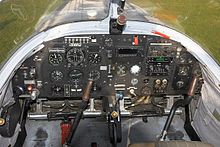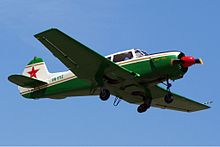Piaggio P. 149
The Piaggio P.149 is a four-seat, single-engine light aircraft produced by the Italian manufacturer Piaggio . It is an all-metal aircraft and conditionally suitable for aerobatics . The Piaggio P.149 was developed in the early 1950s as a further development of the P.148 and was primarily used for civil or military purposes as a training aircraft , liaison aircraft or touring aircraft.
The largest user of the aircraft was the German Air Force , which procured over 260 copies of the aircraft and used them from 1957 to 1990. The Austrian Air Force , the Israeli Air Force and three African countries also use the model in their air forces. The Swiss Aviation School used the model as a standard training aircraft for Swissair pilots .
During the military service in Germany, there were some significant deficiencies in this aircraft, but they were all fixed. Today it is considered good-natured in flight behavior and technically reliable.
After their commercial or military use, many Piaggio P.149s went into private ownership like other training or liaison aircraft. She has the nickname "Pitschi" in aviation circles.
History of creation
At the beginning of the 1950s, the Piaggio company developed a two-seater tail - wheel aircraft that was suitable for beginners and aerobatic training. After around six months of development and construction, the first prototype , named P.148, was completed on February 12, 1951 . Like the successor, the P.148 was a cantilever low- wing aircraft that, unlike the P.149, had a rigid tail wheel landing gear. The P.148 was powered by a Lycoming O-435 . After a trial, the Italian Air Force ordered 100 pieces of the model.
This success stimulated the Piaggio company to further develop the P.148. In the course of this, the number of seats was increased to four by significantly enlarging the cabin, the rigid tail wheel landing gear gave way to a retractable nose landing gear and the engine output was increased to 274 hp through the use of the GO-480 . These changes resulted in a four-seater, fully aerobatic touring aircraft that took off on June 19, 1953 for its first flight.
Construction time, production facilities and quantities
The P.149 completed its maiden flight on June 19, 1953. When and where the last P.149 was produced cannot be ascertained with certainty from the literature. The P.149 was manufactured in different versions in Italy by Piaggio in Genoa .
Of the total of 265 P.149D machines ordered for the Bundeswehr, 75 were manufactured under license by Piaggio itself and 190 by Focke-Wulf in Bremen . The latter received the additional letter "FW" for Focke-Wulf in front of the designation - ie FWP.149D. The first machine built by Focke-Wulf left the production halls at the end of 1957, the end of license production is very likely between 1960 and 1963. In 1965 the production was safely finished, because Jane's 1965/66 no longer listed the P.149D.
The sources do not provide any information about the total production figures, but they agree that the Federal Air Force was by far the largest buyer of the aircraft, although here too the purchase figures vary between 262, 265 and 266.
construction
Construction form and aerobatic suitability
The aircraft is a cantilever low- wing aircraft and was made of light metal in an all-metal construction. The aircraft type has four seats, with two seats next to one another being arranged one behind the other in a closed cabin. The driver's seat is in the front left. The aircraft has dual controls, so it can be steered from both the left and right seats. The landing gear is designed as a nose landing gear construction and is electrically retractable. The aircraft has landing flaps . The P.149 is conditionally suitable for aerobatics, provided that a permissible total weight of 1470 kg is not exceeded and the aircraft is manned by a maximum of two people. The conventionally designed engine, however, limits aerobatic suitability due to its wet sump lubrication , as it is permanently dependent on sufficient engine oil in the oil pan . The fly in the supine position is therefore possible only for a few seconds, otherwise is too little oil in the oil pan and the engine can be damaged due to insufficient lubrication.
See also: Technical data
Motorization

The P.149 is equipped with an engine from the American manufacturer Lycoming . It is a six-cylinder boxer engine with a reduction gear of the type GO-480. In the type designation of the engine, the design is represented by the code letters G for geared ( English for "with gearbox") and O for opposed (English for "opposite", boxer construction) and the displacement in cubic inches . The engine thus has 480 cubic inches, i.e. around 7.8 liters of displacement, and develops 274 hp at 3400 rpm. The permissible continuous output of the engine is 264 hp, with fuel consumption then being around 60 liters per hour. This engine was also used in the Dornier Do 27 , as a result of which the number of units of this engine in the Bundeswehr increased. This is why the engine was manufactured under license by BMW at the time . Piaggio also had a license to manufacture the engine.
Weak points of the construction
During the operation of the P.149, considerable construction defects became apparent. These mainly concerned the landing gear and the wing suspension. Some defects were so serious that at times the entire aircraft fleet was banned from taking off.
As a result of an emergency landing with the landing gear retracted, the aircraft concerned was dismantled and examined for defects . The responsible personnel noticed deformed front wing connection bolts . The entire aircraft fleet was then examined for this defect and the same damage was found several times. By using bolts with higher strength , the deficiency in all aircraft was eliminated in 1960.
It was noticeable that belly landings often took place while the aircraft was in operation , as the landing gear often could not be extended. The emergency device for extending the landing gear also failed in these cases. A universal joint bolt on the landing gear spindle turned out to be the cause of this damage . In order to eliminate the problem, the bolt was made larger and replaced on all aircraft of the type.
Another weak point is the spin properties of the P.149. The aircraft is difficult to spin , but once it has started to spin, it has to be exited again within a few revolutions of the spin. If the spin is not ended quickly, the P.149 tends to switch to the flat spin , from which the aircraft can hardly be brought out again. This weak point was countered with precise symmetry measurements and, if necessary, adjustment, which considerably reduced the tendency to spin.
The aircraft type is now considered to be an aircraft with good-natured flight behavior and technically reliable.
Models
The basic version of P.149 was modified according to the client's wishes and given a corresponding code letter. The versions included the P.149D as a version for the German Federal Armed Forces, the P.149E for the Swiss Aviation School and the P.149U for the Ugandan Air Force. The FWP.149D, which is a German license of the P.149D, plays a special role. See also section: Construction time, production sites and quantities .
Sporting successes
In 1954, Adolf Galland and his co-pilot Eduard Neumann won the Italian flight competition Giro Aereo d'Italia on a P.149. At this point, Galland had just returned from Argentina and started working for German aviation companies. It is therefore obvious that the victory in this competition and Galland's activities had a direct influence on the Bundeswehr's decision to choose the P.149 as the new training and liaison aircraft.
use
The P.149 in its various versions was used primarily for training beginners and as a liaison aircraft. This included both civil and military use in various nations.
Germany
Civil use
The private use of the aircraft was and is rather rare, as the operating costs of the P.149 are well above the level of sport aircraft common in Germany, such as a Robin DR 400 or a Cessna 172 . Nevertheless, many P.149 are still in private hands in Germany and are also flown.
Military use
When looking for a suitable training aircraft for the German Armed Forces, the P.149 prevailed in a comparison flight in 1956/57 against the Saab 91 Safir and the Beechcraft T-34 , a military variant of the Beechcraft Bonanza. Today it can be assumed that the P.149 was able to prevail over the comparative models, among other things because of the large amount of space available, since the aircraft was also to be used as a liaison aircraft in the navy and the air force. In May 1957, Piaggio delivered the first of 72 aircraft ordered to the Air Force. At least 190 aircraft were manufactured under license by Focke-Wulf in Bremen.
The pilot school "S" (FFS "S"), which was transferred to the Lufttransportgeschwader 62 from 1978 , was the first user unit of the P.149 in the Bundeswehr. The prospective pilots had already passed a selection process by the time they entered the FFS "S" and were now given 120 flight hours on the P.149. The flight hours it was initially to a briefing on the pattern on the aerobatic, Tagnavigationsflüge , instrument flights , night flights , cross-country flights and bad weather flights followed. The training flights then ended with a test flight.
By March 1959, the training groups of the FFS "S", which had been stationed at the Memmingen airfield until then , were distributed to various airfields, including the Diepholz air base . There four flight instructors studied an aerobatic program for the public. In the context of the demonstrations, first formation and formation flights with four P.149 took place, then a solo performance with a P.149 from the formation that was polished to a bright metallic finish. After four Bundeswehr starfighters crashed during an exercise for a flight demonstration over Nörvenich on June 19, 1962, resulting in four fatalities, all aerobatic activities in the Bundeswehr were prohibited - including those with the P.149.
Another place where the P.149 was deployed from May 10, 1961 was the flight aspirant regiment (FlAnwRgt) at Uetersen air base . Until then, the flight candidate regiment carried out the tests on the flight candidates on the Piper L18C . African pilots were also trained on the P.149D in the course of economic aid.
In 1963, the flight service squadron of the Air Force 1 Technical School exchanged their Harvard Mk. IV for the Piaggio P.149. The task of the P.149 in this flight service squadron was to represent targets for training purposes of telecommunications personnel.

The navy also used twelve P.149 machines. These were used by the naval service and distress squadron , or the naval aviation squadron 2 and naval aviation squadron 3 "Graf Zeppelin" .
The aircraft was flown at many other Bundeswehr locations and regularly moved with its squadrons. Since many of the Bundeswehr training steps were relocated to the United States or otherwise outsourced, the P.149 were sold by the Bundeswehr via Vebeg GmbH as early as 1972 . When it came to sales, Bundeswehr sports groups were given preferential treatment over private buyers. Nigeria and Uganda also received aircraft of this type from the Bundeswehr as part of economic aid.
On March 31, 1990, the P.149 was officially decommissioned by the Bundeswehr. At the time, it was the Air Force's oldest aircraft.
Israel
In the 1960s, Israel supported several African states, including Uganda, in building their air forces. In 1968 the cooperation with Uganda ended , which had acquired some P.149 in the course of the establishment of the air force. With the end of the cooperation, four Ugandan P.149s were sold to Israel. There they served as light transport and liaison aircraft, retained the Ugandan paintwork, but carried Israeli national emblems . In 1971 the Israeli Air Force decommissioned the P.149. One of the four aircraft had already been destroyed in an accident at this point, the remaining copies were sold overseas.
Austria
The Austrian Air Force used a P.149D from 1958 to 1965.
Nigeria
In 1962, the Nigerian National Assembly approved the creation of a national air force. Various states were involved in the construction, but above all the Federal Republic of Germany, which signed the contract to establish the Nigerian Air Force in 1963 . In addition to personnel, training and material, the contract also included 14 Piaggio P.149Ds for beginner training.
Tanzania
The air force of this country received eight P.149 aircraft in 1965 as part of a cooperation program with the Federal Republic of Germany.
Uganda
The Uganda Air Force received three aircraft called the P.149U, which was a military modification of the P.149. There were also aircraft deliveries from the Federal Republic of Germany as part of economic aid to Uganda. How many aircraft were delivered as part of this economic aid and whether these were the three aircraft with the designation P.149U remains open.
Switzerland
The Swiss Aviation School (SLS) was looking for a new standard training aircraft in the late 1950s and early 1960s. Experienced flight instructors checked various models and the P.149 emerged as the winner on points, whereupon the SLS ordered several aircraft from Piaggio. On April 20, 1961, the first of five P.149E was transferred from Italy to Switzerland. By September 23, 1965, all aircraft ordered in Italy had been delivered. Between 1970 and 1991, seven other P.149D aircraft were delivered to the SLS by Focke-Wulf. SLS used the model as a standard training aircraft for Swissair pilots . The last P.149 in operation at SLS were retired in 1997.
Incidents
The incidents mentioned here do not claim to be complete.
Military incidents of the Bundeswehr
In the following, the military incidents during the deployment of the P.149D in the Bundeswehr are listed, as far as they are known. It shouldn't be confusing if civil aircraft license plates also appear in the list, as some of the training machines were approved by the Lufthansa commercial pilot school.
- On August 13, 1958, the DAA + 392 had an accident in Nörvenich , injuring four inmates.
- On July 25, 1958, two pilots were slightly injured in an emergency landing with the AS + 464 near Wüstenbruck near Ansbach.
- On September 5, 1958, BA + 394 hit the ground with serious consequences, killing the pilot and injuring three passengers.
- On June 30, 1959, the BA + 391 had an accident in Lake Manyas in Turkey . Three people were slightly injured.
- On August 17, 1959, DB + 392 hit the ground on the Boßler , killing one person.
- On July 14, 1960, the AS + 424 had an accident near Diepholz , with two pilots seriously injured.
- On January 18, 1962, two young pilots died in JC + 389 as a result of touching a tree on Dörenberg near Bad Iburg .
- On April 10, 1963, the DF + 391 had to make an emergency landing near Lingen (Ems) .
- On June 30, 1964, the D-EFDI crashed into the Elbe . The pilot was killed.
- On March 29, 1965, the BF + 411 crashed near Blöcktach . The pilot was killed.
- On June 13, 1965, four inmates of EA + 392 in Niederschönenfeld were killed in a crash.
- On January 16, 1968, the D-EJCO collided with a Lockheed C-140 near Bremen Airport . The two pilots of the P.149D were killed in the accident. The C-140 made an emergency landing in Bremen.
- On May 8, 1968, two P.149D collided near Tutzing . The pilot of the 91 + 06 had a fatal accident, while the 91 + 67 made an emergency landing on a field and the occupants were injured.
- On May 15, 1968, the 91 + 87 had to make an emergency landing in France, with the three occupants injured.
- On September 21, 1968, the pilot of the 90 + 90 was killed after a crash near Bernbach .
- On May 9, 1969, while filming, the 91 + 97 collided with a load parachute that was set down from a Transall C-160 near Forstwiesen . The pilot and two cameramen were killed.
- On April 19, 1970 the 90 + 61 crashed near Karlsruhe after touching a tree. The two pilots and the editor of a local newspaper were killed.
- On July 1, 1970, the 92 + 26 crashed in Rudingshain in Vogelsberg . One inmate was killed and two others injured.
- On June 1, 1978, two inmates of the 91 + 44 were killed in Kaufbeuren .
Civil incidents
- On April 27, 2008, both occupants of a P.149D were killed while approaching the Torgau-Beilrode special airfield after the aircraft had tilted to the left from a low height in the area of the left transverse approach. Witnesses had previously noticed the aircraft's engine running irregularly.
particularities
The versions FWP.149D, built under license by Focke-Wulf in Bremen, have a special riveting on the fuselage as a clear distinguishing feature from the original Italian versions of the P.149 . Here the letters “FWP” were nested in one another and riveted into the hull. The letters stand for Focke-Wulf Piaggio .
In pilot circles the aircraft has the nickname "Pitschi", whereby the diction of the nickname (Piggi) is often based on the manufacturer's name. When pronouncing “Pitschi”, the “t” is mostly soft, and the “sch” is mostly spoken voiced (Pidji). Depending on the source, the spellings vary considerably.
Technical specifications
| Parameter | Data from FWP.149D |
|---|---|
| length | 8.78 m |
| Wingspan | 11.12 m |
| Wing area | 18.81 m² |
| height | 3.00 m |
| Wheelbase nose wheel-main landing gear | 2.00 m |
| Maximum take-off mass | 1820 kg |
| Takeoff weight aerobatics | 1470 kg |
| Empty mass | 1160 kg |
| Engine type | Avco Lycoming GO-480-B1A6 |
| Propeller | Three-bladed adjustable propeller Piaggio P.1033G / 4DA |
| Engine power | 201 kW (274 hp) |
| Maximum speed at sea level | 303 km / h |
| Top speed in 3000 m | 272 km / h |
| Service ceiling | 5380 m |
| Normal range | 1050 km |
| Take-off distance in 305 m, 5 ° C, 1600 kg | 525 m |
| Landing distance in 610 m, 18.5 km / h headwind, 1500 kg | 530 m |
| crew | one to four people |
| Fuel supply | 236 l of which 5 cannot be used |
Comparable aircraft types
The Jakowlew Jak-18T can be compared with the Piaggio P.149 . Along with the P.149, it is one of the few four-seater fully aerobatic aircraft. The age, the engine performance and the overall design with retractable nose landing gear and seating arrangement are also comparable. A notable difference is the cruising speed , which is significantly higher with the P.149. In return, the Jak-18T has a significantly shorter take-off and landing distance.
The Pilatus P-3 is also often used as a comparison sample. The P-3 is similar to the P.149 both in appearance and in the basic concept as a cantilever low-wing aircraft with retractable nose landing gear. The most significant difference is the number and arrangement of the seats. While the Piaggio P.149 was also used as a liaison aircraft due to its four seats, the Pilatus P-3 served as a two-seater with seats arranged one behind the other, primarily as a training aircraft for future pilots of fighter jets with jet engines .
Web links
Individual evidence
- ↑ a b c d e f g h i j Siegfried Wache: Piaggio P-149 D (F-40 aircraft of the Bundeswehr). Arbeitsgemeinschaft Luftwaffe eV (AGL), 1994, p. 3.
- ↑ a b c Manfred Griehl: Typenkompass Focke-Wulf since 1925. Motorbuch Verlag, 2009, p. 118.
- ↑ a b Retrofitting instructions for silencer LIESE 2x76x300-L for the Piaggio (FW) P 149 D. Hermann LIESE FLUGTECHNIK, July 25, 1997, archived from the original on March 27, 2014 ; Retrieved December 12, 2012 .
- ↑ Leonard Bridgman (ed.): Jane's All The World's Aircraft - 1959-60 , 1959, on page 180 is still reported on the ongoing license production
- ↑ Karlheinz Kens: Aircraft Types - Type Book of International Aviation , 1963, on page 106 the license production is mentioned in the past tense
- ^ John WR Taylor (Ed.): Jane's All The World's Aircraft - 1965-66 , 1965
- ↑ Student thesis by Oliver Engels: Historical overview of the Bundeswehr aircraft, University of the Bundeswehr Munich, 2000. (PDF; 3.5 MB) Archived from the original on January 1, 2017 ; Retrieved December 1, 2012 .
- ^ A b Siegfried Wache: Piaggio P-149 D (F-40 aircraft of the Bundeswehr). Arbeitsgemeinschaft Luftwaffe eV (AGL), 1994, p. 6.
- ↑ a b c Tobias Billig: Piaggio P-149D. In: History of the Air Force. Federal Ministry of Defense, August 7, 2012, accessed on December 1, 2012 .
- ↑ Gruppo Modellisto Sestese via dei p.149 (Italian). Archived from the original on May 2, 2015 ; Retrieved December 26, 2012 .
- ↑ Sportfluggruppe Oldenburg: Italian Flight History P.149. (PDF; 33 kB) Archived from the original on September 20, 2010 ; Retrieved December 26, 2012 .
- ↑ a b c ... then came the "Piggi". (PDF; 11.9 MB) Archived from the original on March 27, 2014 ; Retrieved December 5, 2012 .
- ↑ History of the Air Force: Flugunlück aerobatic team . Retrieved February 10, 2013 .
- ↑ a b c d Siegfried Wache: Piaggio P-149 D (F-40 aircraft of the Bundeswehr). Arbeitsgemeinschaft Luftwaffe eV (AGL), 1994, p. 4/5.
- ↑ a b c History of the Air Force: Piaggio P-149D . Retrieved February 10, 2013 .
- ^ Bavarian Aircraft Historians eV: Air Force aircraft 1956 - 2006 . Retrieved February 12, 2013 .
- ^ Israeli Air Force Light Aircraft (English). Retrieved December 5, 2012 .
- ^ History of the Air Force: Training Aid for the Nigerian Air Force . Retrieved March 2, 2013 .
- ↑ mongabay.com: Nigeria Air Force . Retrieved December 6, 2012 .
- ↑ DER SPIEGEL 10/1965: Heia Safari. Retrieved December 5, 2012 .
- ↑ Swissaviation.ch: Five types in 38 years . Retrieved March 4, 2013 .
- ↑ Swissaviation.ch: Five types in 38 years (2) . Retrieved March 4, 2013 .
- ^ Wings Aviation: SLS Swiss Aviation School. Retrieved February 12, 2013 .
- ^ Siegfried Wache: Piaggio P-149 D (F-40 aircraft of the Bundeswehr). Arbeitsgemeinschaft Luftwaffe e. V. (AGL), 1994, p. 39.
- ^ Report of the Aviation Safety Network on the accident. Retrieved December 1, 2012 .
- ^ BFU accident report on the accident in question. Retrieved February 12, 2013 .
- ^ RK Flugdienst about their Piggi. Retrieved December 5, 2012 .
- ↑ Luftfahrt-Bundesamt: Aircraft identification sheet No. 568, FW P 149 D series . Retrieved March 4, 2013 .









